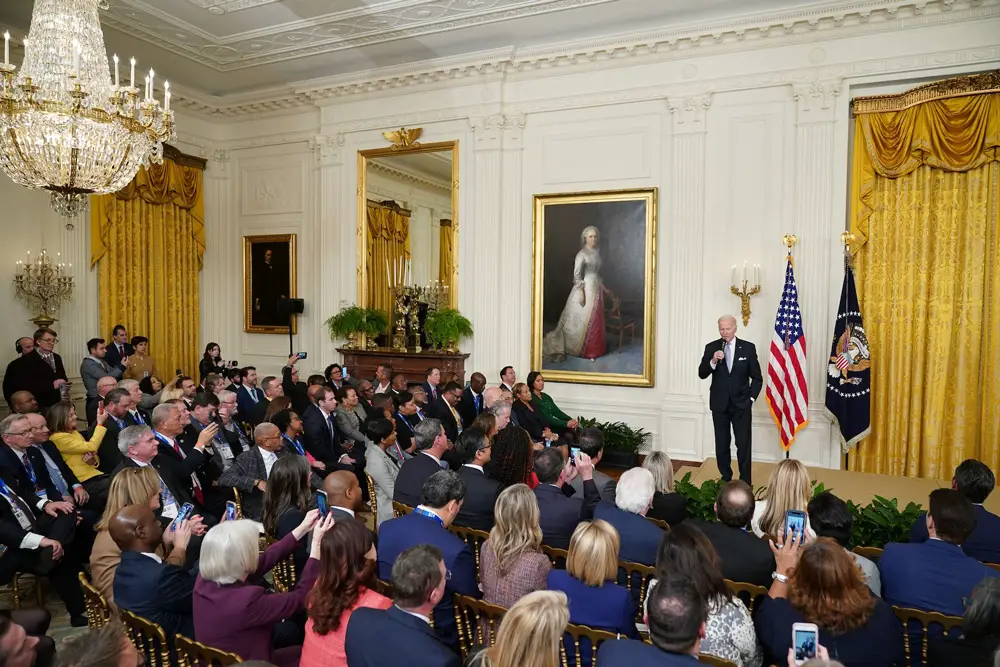
By Justin de Benedictis-Kessner
Elected representatives in government don’t always look like the people they serve.
The people who serve in local governments – cities, counties and other entities below the state level – represent the vast majority of elected officials in the U.S. My recent research with Diana Da In Lee, Yamil Velez and Chris Warshaw finds that, like in the federal and state governments, nonwhite people are drastically underrepresented in local government.
We gathered elections data on city, county and school district elections over the last three decades from medium and large places – any city with a population of at least 50,000 people and any county with a population of at least 75,000 in 2020. These 877 different cities and 1,005 different counties encompass more than half of the U.S. population. Using that data, we calculated the share of winning candidates who were members of several racial and ethnic groups.
In each place, we compared the percentage of the population from each of those demographic groups with the percentage of elected officials from those same groups. This allowed us to gauge whether each of these demographic groups was proportionally represented, or if they were overrepresented or underrepresented among their local politicians.
Municipal officials
Across cities in the U.S., we looked at the offices of mayor and city councilor. One commonality stands out: Nearly universally, the percentage of elected officials who are white is higher than the white share of the population. This overrepresentation persists from the early 1990s – the first time period from which we have data – to more recent years among mayors. Among city councilors, it’s a bit closer to parity with the population.
For mayors in recent years, there is a particularly large gap: On average, 78% of mayors are white, while only 68% of the population in the cities in our data is white. City councilors, on the other hand, tend to look much more like the population in their cities.
This overrepresentation of white residents comes at the expense of Hispanic and Asian residents. Nearly 17% of residents in cities are Hispanic and 5% are Asian. But only 6% of mayors are Hispanic and only 2% are Asian.
County officials
In medium and large counties where we collected elections data, we made similar comparisons for county executives, county legislators, sheriffs and prosecutors. Again, across these local elected offices, there are far more, as a percentage, white elected officials than there are white residents of these counties.
Just under 70% of residents of the counties in our data are white. But over 76% of county executives are white, over 85% of county legislators are white, 83% of sheriffs are white, and nearly 89% of prosecutors are white.
Again, the overrepresentation of white residents among local elected officials happens as other racial and ethnic groups are underrepresented in their county governments. Black residents make up 11% of the population in counties in our data, but only 9% of county legislators. And Hispanic and Asian residents are more drastically underrepresented in county offices. In our data, 11% of county residents are Hispanic, while 3% are Asian. But 5% or less of politicians holding office in any county elected position are Hispanic. And Asians make up 1% or less of elected county legislators, sheriffs and prosecutors.
School boards
Data on school boards’ representation is less clear because our data collection on school boards was less comprehensive than our data on city and county elections. But the apparent trend among the school districts where we gathered data is similar.
School boards have become a flashpoint for various political efforts, including teaching about race and racism and requests to ban books. And they are substantially more white than the communities they serve.
Less than half of the constituents in the school districts in our data are white, but more than two-thirds of school board members are white. Of the districts in our study, 22% of the residents were Black and 6% were Asian, but just 10% of board members are Black and just 3% are Asian. Hispanic residents, who made up 24% of the population, were more closely represented, but still not equally, with 20% of board members.
What does this mean for representation across the U.S.? Local elected officials make important and often contentious decisions governing the lives of millions of city and county residents. Race and other demographic features of both residents and elected officials do not, by any means, offer a conclusive picture of their respective policy preferences. But the fact that local governments look so different from their residents doesn’t paint a sunny picture of representation in local government.
![]()
Justin de Benedictis-Kessner is Assistant Professor of Public Policy at Harvard Kennedy School.






























JimboXYZ says
It’s a math thing, There are way more residents than elected officials. Take Flagler County or any City Government, 120K population can mathematically have a finer percentage because each represents a smaller percentage. 1 person out of 120K is 0.000833333%, where as 1 person in say 50 elected positions is 2 percentage points. If the elected official is elected they got the votes, had nothing to do with their skin color. Each candidate has to pay a fee to run for an elected position. The percentages are close enough for the DE&I stats for head counts. Any government adheres to the percentages when they get Federal & State grants & funding. Enough with the whine because there aren’t enough minorities running the show. Maybe go to Harlem or any other Black majority and see how many whites get elected there ?
One can’t make anyone run for Office. Remember Barbosa ? He would’ve counted towards the Hispanic representation. But let’s face it, he couldn’t resign soon enough for quite a few voters. Remember Milissa Holland, she resigned, she was white & female as Mayor of Palm Coast, we had to hold another election to get the Alfin era, there were several candidates that ran, not sure how many non-whites, non-males or LGBTQI were on the ballot.
Rob says
What is the problem with just Americans representing Americans? Why does race need to be part of it? You make it sound like certain groups can only be represented by someone of their own skin color. All that does is to work to divide us, not bring us together as one nation. But I guess in the end, division is what keeps one party in power.
Ray W. says
Thank you for condemning as divisive the party that asks when it can begin beheading liberals, for condemning the governor of the party who announced his intent to “slit throats” if elected to the presidency, and for condemning the candidate who promises to crush “vermin.” Our nation does not need such rhetoric from its leaders, some in power, some seeking power.
Angela says
Without DEI the “white” voice has been predominant at most tables; therefore, mostly white perspectives are represented in our policies.
melly says
I’m real, *real* tired of my government pitting races against one another. It’s disgusting and wrong no matter what “color” you’re talking about. COLOR DOES NOT MATTER and I am not paying taxes for my locality, city, state or country to try and demonstrate otherwise. I’m even sicker of a local press which persists in pushing this notion.
The people perpetuating this nonsense need to be loudly and thoroughly shamed until they knock it off. “Just doing what I’m told” is not an excuse. Sit down and stop worrying about everybody’s skin color and start worrying about showing the employees you have how to actually do the jobs they’re put in place to do. They are not there to worry about melanin levels of their coworkers and constituents, and neither are you.
Ed P says
Shouldn’t the best possible qualified candidates be hired or elected?
Qualifications matter more than ethnicity, race, religion, or even chosen pronouns.
Is anything right with America? Does everyone have an axe to grind?
Next we will be complaining that someone with 2 PHDs is too educated for a role in government or someone’s high AGI would disqualify them.
I’m unhappy with the racial balance of the NBA and the NFL talent be damned it’s not FAIR …where are all the Asians and Hispanics?
Come on man.
dave says
Agree 100%, ” Shouldn’t the best possible qualified candidates be hired or elected?
Qualifications matter more than ethnicity, race, religion, or even chosen pronouns.”.
Atwp says
Nothing I didn’t know. When communities go belly up, we know who to blame.
DaleL says
Justin de Benedictis-Kessner has presented some data and some charts which appear to represent a problem. I think it is incomplete and definitely an over generalization. One issue I have is that local populations can have different mixes of people beyond just race. There is age to take into account. Some suburban towns can be in transition from a majority older Caucasian (White) population to an ethnically more diverse younger population. The younger people tend to have children. The children count as to the school district population, but do not vote. The school board is elected by voters. Even amongst people of voting age, historically younger people don’t vote to the same degree as older people. As a result, the school board matches more closely the demographics of the voters, not the population. That is democracy.
My conclusion, the story lacks detail and context.
dave says
Well, you put your name on the ballet if you qualify and run for office, if you get elected by your community, county, state etc…you made it in office. End of story. There is NO disqualification based on color, race, religion
ITs:
* County Commission candidates must reside in the district they are seeking at the time of being elected to office in November
* School Board candidates must reside in the district they are seeking at the time of qualifying
* Constitutional Officers must reside in the district they are seeking at the time of assuming office
* Judicial candidates must reside in the district they are seeking at the time of assuming office
And most important: You file the required forms on time, pay your fees and get approval from the elections supervisor.